Discover Florida Nature
It's time to explore the natural Florida


|
|
|
|
|
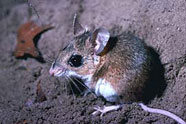 Florida
Mouse (Podomys floridanus) SSC- The Florida Mouse, sometimes
called the gopher mouse, is found only in Florida on sandy beaches and
scrub-brush. In fact, the Florida Mouse is the only mammal that is
limited to Florida. The Gopher Tortoise makes its home here in burrows,
and the Florida Mouse uses the tortoise burrow, making its home in a
corridor off of the main route for the tortoise. If a tortoise burrow is
not available, the Florida Mouse will often use a discarded burrow of
the oldfield mouse. The mouse is nocturnal, using cover of darkness to
escape from predators and is active all year. Even though it is
considered large for its species, the Florida Mouse is small, only
growing to an average length of 5-8 inches, with a long tail that
usually attains a length of 3-5 inches. Florida mice have a distinctive
odor, almost like a skunk. Florida
Mouse (Podomys floridanus) SSC- The Florida Mouse, sometimes
called the gopher mouse, is found only in Florida on sandy beaches and
scrub-brush. In fact, the Florida Mouse is the only mammal that is
limited to Florida. The Gopher Tortoise makes its home here in burrows,
and the Florida Mouse uses the tortoise burrow, making its home in a
corridor off of the main route for the tortoise. If a tortoise burrow is
not available, the Florida Mouse will often use a discarded burrow of
the oldfield mouse. The mouse is nocturnal, using cover of darkness to
escape from predators and is active all year. Even though it is
considered large for its species, the Florida Mouse is small, only
growing to an average length of 5-8 inches, with a long tail that
usually attains a length of 3-5 inches. Florida mice have a distinctive
odor, almost like a skunk.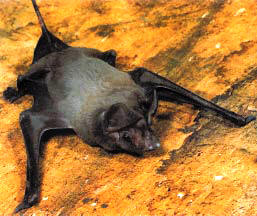 Florida
Mastiff Bat
(Eumops glaucinus floridanus) Endangered- A large bat, The Florida
mastiff bat measures between 4.9 -6.5 inches. This bat a a black,
grey-brown, or cinnamon brown upper side, and a greyish underside, The
Florida mastiff bat is short haired and has a long tail, extending
beyond the membrane for half it's length. Found in Southern Florida,
mainly in Broward, Miami-Dade, Collier, and Monroe counties, this bat
roosts in palms and hollow trees, and in buildings. The Florida mastiff
bat emerges to forage much later than most bats, leaving well after
dark. They seldom forage lower than 30 feet. These bats can take flight
from horizontal surfaces, a feat most of our bats can't do easily. Florida
Mastiff Bat
(Eumops glaucinus floridanus) Endangered- A large bat, The Florida
mastiff bat measures between 4.9 -6.5 inches. This bat a a black,
grey-brown, or cinnamon brown upper side, and a greyish underside, The
Florida mastiff bat is short haired and has a long tail, extending
beyond the membrane for half it's length. Found in Southern Florida,
mainly in Broward, Miami-Dade, Collier, and Monroe counties, this bat
roosts in palms and hollow trees, and in buildings. The Florida mastiff
bat emerges to forage much later than most bats, leaving well after
dark. They seldom forage lower than 30 feet. These bats can take flight
from horizontal surfaces, a feat most of our bats can't do easily. 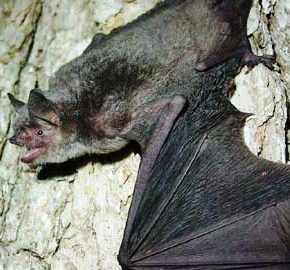 Gray
Bat (Myotis grisescens) Endangered- Gray bats are distinguished
from other bats by the uncolored fur on their back. In addition,
following their molt in July or August, gray bats have dark gray fur
which often bleaches to a chestnut brown or russet. They weigh 7-16
grams. The bat's wing membrane connects to its ankle instead of at the
toe, where it is connected in other species of
Myotis. The federally endangered gray bat is one of a few
species that live in caves year-round. Most of Florida's gray bat
population is found in Jackson County, on the Florida/Georgia border
west of Tallahassee. The foraging habitat of gray bats is over riparian
areas (river banks) and often over water. The gray bat eats a variety of
flying aquatic and terrestrial insects present along rivers or lakes. Gray
Bat (Myotis grisescens) Endangered- Gray bats are distinguished
from other bats by the uncolored fur on their back. In addition,
following their molt in July or August, gray bats have dark gray fur
which often bleaches to a chestnut brown or russet. They weigh 7-16
grams. The bat's wing membrane connects to its ankle instead of at the
toe, where it is connected in other species of
Myotis. The federally endangered gray bat is one of a few
species that live in caves year-round. Most of Florida's gray bat
population is found in Jackson County, on the Florida/Georgia border
west of Tallahassee. The foraging habitat of gray bats is over riparian
areas (river banks) and often over water. The gray bat eats a variety of
flying aquatic and terrestrial insects present along rivers or lakes.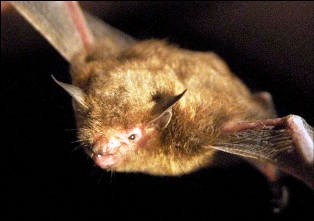 Indiana
Bat (Myotis sodalis) Endangered- The Indiana bat is a small
bat, less than 2 inches in length, with dark gray to brownish black fur.
Characteristics that help distinguish it from similar species include a
pinkish nose, small hind feet with sparse, short hairs that do not
extend beyond the toes, and a calcar (the spur extending from the ankle)
that has a slight keel. Its hair is less glossy in appearance than that
of little brown bats. The Indiana bat is found throughout much of the
eastern United States from Oklahoma, Iowa, and Wisconsin, east to
Vermont and south to northwestern Florida. Indiana bats mate in the fall
and begin entering hibernation in October. Males tend to be active
longer in the fall, but are hibernating by late November. During
hibernation, Indiana bats cluster tightly together and, as a result, are
sometimes called the social bat. Indiana
Bat (Myotis sodalis) Endangered- The Indiana bat is a small
bat, less than 2 inches in length, with dark gray to brownish black fur.
Characteristics that help distinguish it from similar species include a
pinkish nose, small hind feet with sparse, short hairs that do not
extend beyond the toes, and a calcar (the spur extending from the ankle)
that has a slight keel. Its hair is less glossy in appearance than that
of little brown bats. The Indiana bat is found throughout much of the
eastern United States from Oklahoma, Iowa, and Wisconsin, east to
Vermont and south to northwestern Florida. Indiana bats mate in the fall
and begin entering hibernation in October. Males tend to be active
longer in the fall, but are hibernating by late November. During
hibernation, Indiana bats cluster tightly together and, as a result, are
sometimes called the social bat.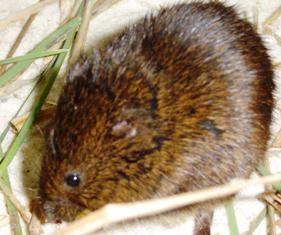 Florida
Salt marsh Vole (Microtus pennsylvanicus dukecampbelli)
Endangered-The Florida salt marsh vole is a small, short-tailed rodent
with a blunt head and short ears. Its fur is black-brown dorsally and
dark gray ventrally. It is closely related to the meadow vole, but can
be distinguished by its larger size, darker coloration, relatively small
ears, and by certain skull characteristics. Voles can be active during
days and nights, and they spend most of their time feeding on grasses,
seeds, and probably some insects. The Florida salt marsh vole seems to
prefer areas in the salt marsh dominated by seashore salt grass,
especially where this grass is tall and dense. The voles form runways
beneath the tall grass and are rarely, if ever seen. While voles are
excellent swimmers, it is assumed they survive long periods of high
water by clinging to the tops of vegetation. Voles have a life span of
only six months, and they begin breeding at two months of age. The salt
marsh vole is so rare that before April of this year only 15 individuals
of this subspecies had been found in the last 22 years, all at one site
near Cedar Key, Florida. Since 1982, efforts by numerous researchers
have been unable to document voles anywhere else within Florida’s Big
Bend region. Florida
Salt marsh Vole (Microtus pennsylvanicus dukecampbelli)
Endangered-The Florida salt marsh vole is a small, short-tailed rodent
with a blunt head and short ears. Its fur is black-brown dorsally and
dark gray ventrally. It is closely related to the meadow vole, but can
be distinguished by its larger size, darker coloration, relatively small
ears, and by certain skull characteristics. Voles can be active during
days and nights, and they spend most of their time feeding on grasses,
seeds, and probably some insects. The Florida salt marsh vole seems to
prefer areas in the salt marsh dominated by seashore salt grass,
especially where this grass is tall and dense. The voles form runways
beneath the tall grass and are rarely, if ever seen. While voles are
excellent swimmers, it is assumed they survive long periods of high
water by clinging to the tops of vegetation. Voles have a life span of
only six months, and they begin breeding at two months of age. The salt
marsh vole is so rare that before April of this year only 15 individuals
of this subspecies had been found in the last 22 years, all at one site
near Cedar Key, Florida. Since 1982, efforts by numerous researchers
have been unable to document voles anywhere else within Florida’s Big
Bend region. 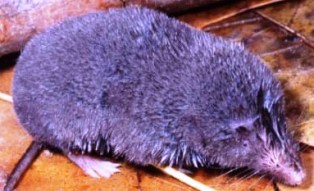 Sherman’s
Short-Tailed Shrew
(Blarina carolonensis shermani) SSC- The Sherman short-tailed
Shrew is found in southwestern Florida. It is dark gray, 3.5-5 inches
long, and has a short (.5-1") tail. Diet of the Sherman's short-tailed
shrew includes small snakes, mice, snails, slugs, centipedes,
millipedes, insects, spiders, and earthworms. This shrew's saliva is
poisonous, allowing it to prey on animals much larger than itself. Sherman’s
Short-Tailed Shrew
(Blarina carolonensis shermani) SSC- The Sherman short-tailed
Shrew is found in southwestern Florida. It is dark gray, 3.5-5 inches
long, and has a short (.5-1") tail. Diet of the Sherman's short-tailed
shrew includes small snakes, mice, snails, slugs, centipedes,
millipedes, insects, spiders, and earthworms. This shrew's saliva is
poisonous, allowing it to prey on animals much larger than itself.
|
|
|
Advertise | Privacy Statement | Dog Encyclopedia | Video |Contact | Alaska Nature |
|